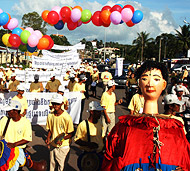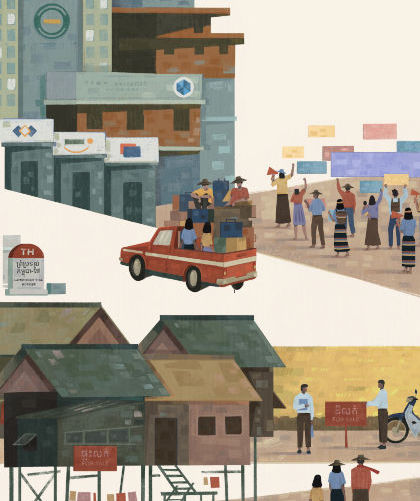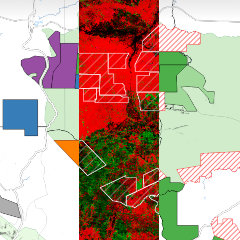Children in Cambodia suffer from the worst forms child labor
Published on 29 August 2007Although Cambodia has seen rapid economic growth in recent years, it is still one of the poorest countries in the world with most of its citizens living in poverty. The reality of poverty is that it is indiscriminate and affects not only adults but also children. This sadly forces many young children to engage in domestic and manual labor to support their families, with a large proportion working under severe conditions. According to the NGO Committee on the Rights of the Child (2006 NGO Statement to the Consultative Group), Cambodia has more than 1.5 million child laborers, of whom 250,000 are working in the most severe forms of child labor such as in brick factories, brothels, drug factories and mines. Research by the National Institute of Statistics in 2003 indicated that in Phnom Penh alone there were 27,950 children working as domestic workers. These children do not have an opportunity to receive an education and most of them face exploitation and physical and verbal abuse, every day.
Cambodia has more than 1.5 million child laborers
On August 18, 2007, LICADHO's Child Rights Office (CRO) in cooperation with World Vision Cambodia (WVC) launched their campaign to combat the worst forms of child labor under the theme 'I protect children, do you?' The campaign launch was held at Phnom Penh's Old Market (Phsa Chas) and was attended by approximately 2,000 people including child protection group (CPG) members, representatives of brick factory owners, parents and guardians of working children, NGOs representatives, local authorities and the public.
The LICADHO/WVC campaign is a part of a two-year project that aims to raise public awareness on the worst forms of child labor and the impact that it has on children's morale, safety, education, health, and physical and mental development. One of its major focuses is to understand the vital role children play in Cambodia's social and economical development. It also highlights the abuse and hardship of children working as domestic workers, in brick factories and in night clubs and restaurants.
In another campaign titled "To Secure Children's Rights in Cambodia", LICADHO's CRO (with the European Union and DanChurchAid), organized a public march in Sihanoukville on August 24. Members of CPGs, government officials, police officers and local NGO workers from M'Lop Tapang, LAC, CCBO and APLE, all participated in the march. The march aimed to raise public awareness on the need to protect children from trafficking and sexual exploitation.
Two cases reported to LICADHO in early 2007 reveal the brutal extent of child labor in Cambodia's brick factories. One incident involved a 14-year old girl who lost her arm while she was operating a clay machine. The girl had been indebted to the brick factory owner for one million Riel (USD$250), a debt which was owed by her father. She had left school in order to pay off the debt. In another incident a 13-year old boy lost four of his fingers while he was working with heavy machinery. The boy was trying to earn money to buy a bicycle so he could ride to school which was very far from his house. It was his first day of work at the brick factory.
LICADHO also receives cases which exposes the abuse and exploitation of children as domestic workers. In one case a 15-year old girl was indebted to a well-off businessman after her mother purchased land from the businessman in exchange for her daughter's domestic services for 3 years. Every day, the girl had to work for 16 hours straight, from 4am to 8pm. She looked after the businessman's children, cleaned the house, cooked the food, washed the clothes, tended the garden and planted trees. She could not to go to school at all. Finally, the businessman demanded the mother repay the debt even though her daughter had completed 3 full years of service.
Under the International Labor Organization (ILO) Convention No. 182 and Recommendation No. 190 on Worst Forms of Child Labor (which was ratified by Cambodia in October 2005) the term "the worst forms of child labor" comprises:
(a) All forms of slavery or practices similar to slavery, such as the sale and trafficking of children, debt bondage and serfdom and forced or compulsory labor, including forced or compulsory recruitment of children for use in armed conflict.
(b) The use, procuring or offering of a child for prostitution, for the production of pornography or for pornographic performances;
(c) The use, procuring or offering of a child for illicit activities, in particular for the production and trafficking of drugs as defined in the relevant international treaties.
(d) Work which, by its nature or the circumstances in which it is carried out, is likely to harm the health, safety or morals of children.
Article 177 of Cambodian Labor Law states that the minimum age for wage employment is 15 years. Children from 12 to 15 years of age can be hired to do light work provided that: (a) the work is not hazardous to their health or mental and physical development and (b) the work will not affect their regular school attendance.
LICADHO strongly appeals to employers of child laborers to comply with the International Child Labor Convention and Cambodian Labor Law. Employers need to ensure that working conditions are safe and that health care is provided for child laborers, furthermore these children must have access to an education. Governmental authorities, civil society and the private sector must work together to rescue child laborers and provide them with physical and mental rehabilitation services and to ultimately stop the abuse and exploitation of Cambodia's children.
- Topics
- Children's Rights Forced Labour
- Related








